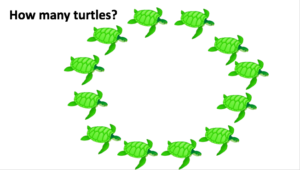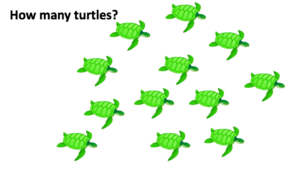MAFS.K.CC.2.5: Count to answer “how many?” questions about as many as 20 things arranged in a line, a rectangular array, or a circle, or as many as 10 things in a scattered configuration; given a number from 1–20, count out that many objects.
Video Example (pennies not specifically noted in the Florida standard.)
Cognitive Complexity Level: 1-Recall
[divider] [/divider] Students are able to…
- Count out a number of items using a variety of concrete objects in a variety of arrangements
- Circle a number of items and write the matching numeral
- Draw a given number of items
[divider] [/divider] Students are able to…because teachers:
- Provide a variety of concrete experiences before students draw pictures.
- Progress from organized, linear representations to scattered configurations.
- Provide opportunities for students to match a quantity with a number AND produce a number of objects when given materials or asked to draw a picture.
- Use manipulates such as dot cards, dominoes, and dice to promote subitizing of quantities.
[divider] [/divider] Questions to ask students:
- Show students a collection of objects arranged in a line and ask students, “How many do you think there are?” Ask students to count the objects and follow up with, “How many are there?” Use same collection of objects to arrange randomly. Ask students, “How many are there?”
- Sample answer that indicates understanding: Students keep track of objects counted, identifies the last number stated as the total number counted, and correctly counts objects in a line and in random arrangement.
- Sample answer that indicates an incomplete understanding or a misconception: Students skip number names in standard order or does not keep track of objects counted.
- Was it hard to count the objects when they were scattered? What could you do to make counting them easier?
- How could you be sure not to miss any objects when counting?
[divider] [/divider] Additional Resources:
Additional in depth content knowledge
Blog Post:
Subitizing, A funny name for a serious topic!
Video: Subitizing in your classroom
[divider] [/divider] Sample Formative Assessment Tasks:
[divider] [/divider] Resources/Tasks to Support Your Child at Home
Task: Count out counters (cereal, pretzel sticks, cotton balls etc.) up to five. Move the arrangement around and pose questions such as, “How many objects are there?” move the objects around and ask, “What about now?”

